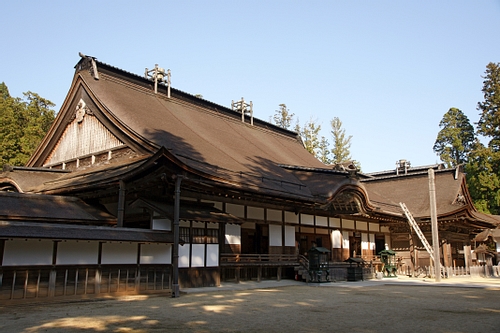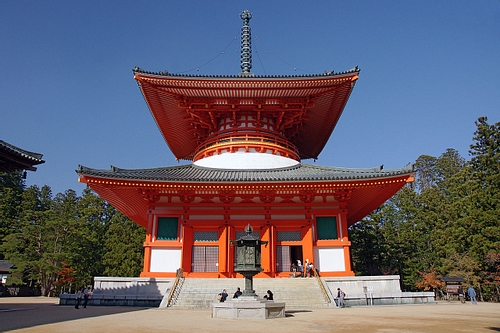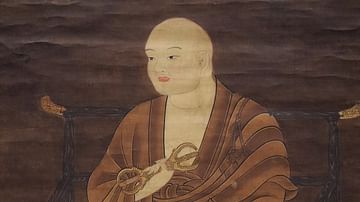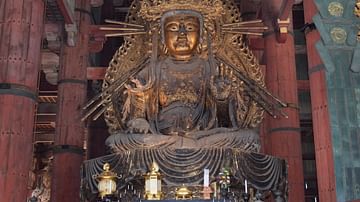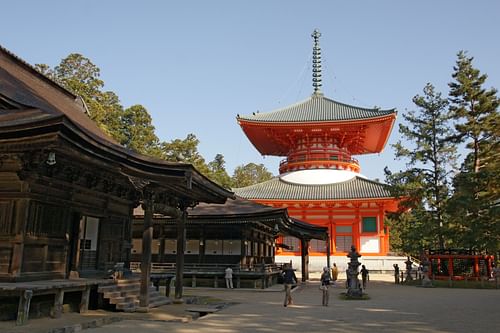
Mount Koya (aka Koyasan), located in the Wakayama Prefecture, south of Osaka, Japan, is the site of a temple complex founded in 819 CE by the scholar monk Kukai as the headquarters for Shingon Buddhism. There are temples and sacred buildings around the base of the mountain, on its slopes and on the top plateau which is 820 metres (2,690 ft) above sea level. Mount Koya is a UNESCO World Heritage Site.
Shingon Buddhism
Kukai (774-835 CE), was a scholar, poet, sculptor, monk, and general miracle worker who founded Shingon Buddhism in Japan. Kukai studied in China under the master Hui-kuo, abbot of the Ching Lung (Green Dragon) Temple and, chosen as the master's successor, was suitably initiated. Thus, he became an advocate of Esoteric Buddhism or mikkyo, which meant that only the initiated, only those who gave up their worldly life and resided in a monastery could know the Buddha and so achieve enlightenment.
The Shingon (or 'True Word') Sect which Kukai studied in China (there known as Quen-yen) had made its way from southern India. It held that Buddhist teachings came from the cosmic Buddha Mahavairocana (Dainichi to the Japanese). Crucially, Shingon Buddhism proposed that an individual could achieve enlightenment in their own lifetime and need not wait for death. Rituals included meditation carried out while the body was held in various postures, sacred hand gestures (mudras), and the repetition of secret formulas or mantras. Great importance was given to the power of prayer.
Mt. Koya Monastery
In 819 CE Kukai created a centre for his esoteric doctrine on Mount Koya in the modern Wakayama Prefecture, 80 km (50 miles) from the then capital Heiankyo (Kyoto). According to legend, the monk chose the site after meeting a hunter with one white and one black dog on the mountain slopes. This figure was the son of the Shinto kami or spirit of Mt. Koya, and he kindly gave Kukai permission to build his Buddhist temple there in a story which highlights the traditional coexistence between the two religions in ancient Japan. The Shinto goddess is still represented on the mountain by the Niutsushime Jinja at the top and the Niukanshofu shrine at the base.
The temple complex is still today the headquarters of the Shingon Buddhist Sect. Here, educated devotees could reach enlightenment, it was promised, not by the lifelong study of sutras but by viewing mandalas, the stylised visual representation of the teachings of Buddha. Not only a base for scholars and monks, Mt. Koya soon became a popular site of pilgrimage, although, it was not accessible to women until 1872 CE.
Kukai also established a route of pilgrimage - the longest and most famous in Japan - which is a 1,600 km (1,000 miles) circuit which stops at 88 temples, many of them built where the monk was said to have performed a miracle. Kukai died in 835 CE - he had predicted the very day - and was buried in a tomb on Mount Koya. In 921 CE Kukai was given the posthumous title of Kobo Daishi meaning 'Great Teacher of Spreading the Law' by the emperor.
Architectural Highlights
The Jison-in pagoda is part of the temple complex at the mountain base and marks the start of the Choishimichi pilgrimage trail which winds up the slopes stopping at various sacred sites along the way. The walk takes 8 hours and follows 180 stone markers where the faithful should stop at pray. Midway up the mountain is the Shinto Niutsushime shrine which has a two-storeyed Offertory building, wooden bridge, carp pond, and a torii or sacred gate.
At the top of the mountain on a plateau is the site of the original temple built by Kukai. The Danjo Garan precinct has 20 structures which include a memorial hall, three pagodas, and the large Daimon Gate with its Nio guardian statues to ward off evil spirits. The main pagoda here is the Daito Pagoda with its impressive double roof and interior mandalas illustrating Shingon Buddhism. First built in 819 CE, the structure was destroyed by fire but rebuilt in 1937 CE.
The head temple of the mountain, the Kongobu-ji, is next to the Danjo Garan precinct, and here is the Kondo or Main Hall which is a reconstruction dating to 1932 CE. Unlike its predecessors, the building is equipped with two large water buckets on the roof and a permanently placed ladder so as to better fight any outbreak of fire. Here, too, is the largest rock garden in Japan. The mausoleum of Kukai and the Torodo memorial hall is also part of the temple complex and is reached by the Gobyobashi bridge. Across the bridge, in the sacred area of the tomb, visitors are required not to eat, smoke, or use cameras. Other sites of note in the vicinity include two Tokugawa mausoleums, the Okunoin Cemetery with its hundreds of statues of the bodhisattva Jizo, many wearing a red bib for good luck, and the small Kongo Sammai-in monastery.
This content was made possible with generous support from the Great Britain Sasakawa Foundation.
